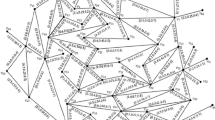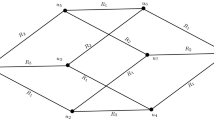Abstract
Nowadays the fuzzy graphs gained popularity due to their wide applications in different areas of science, engineering, social sciences, etc.In this paper, we consider covering problem in fuzzy graph. Different types of covering problems have been defined in this paper. Almost all problems are new. For each of these problems separate study is required. Also, the covering set, strong covering set, minimal covering set, etc., are defined and explained with examples. In a graph, each vertex can cover only those vertices that lie within its covering radius along shortest path and no vertex can cover itself. Here, an algorithm is designed to find the different types of covering sets on a fuzzy graph. An imprecise number, instead of a real number, namely interval number and triangular fuzzy number are considered as arc length of a fuzzy graph. To the best of our knowledge no works are available for covering problem on fuzzy graphs/networks. An application of covering set in natural disaster management is discussed to highlight the importance of the covering problem. In this application, an algorithm is designed to find all the facility vertices (or supply vertices) for given vertex and covering radius.




Similar content being viewed by others
References
Abu Nayeem SkMd, Pal M (2005) Shortest path problem on a network with imprecise edge weight. Fuzzy Optim Decis Mak 4:293–312
Agarwal PK, Ezra E, Sharir M (2012) Near-linear approximation algorithms for geometric hitting sets. Algorithmica 63:1–25
Bhutani KR, Battou A (2003) On \(M\)-strong fuzzy graphs. Inf Sci 155(1–2):103–109
Chaudhry SS (1993) New heuristics for the conditional covering problem. Opsearch 30:42–47
Chaudhry SS, Moon ID, McCormick ST (1987) Conditional covering: greedy heuristics and computational results. Comput Oper Res 14:11–18
Clarkson KL, Varadarajan KR (2007) Improved approximation algorithms for geometric set cover. Discrete Comput Geom 37:43–58
Dinur I, Safra S (2005) On the hardness of approximating minimum vertex cover. Ann Math 162(1):1–32
Dubois D, Prade H (1983) Ranking fuzzy numbers in the setting of possibility theory. Inf Sci 30:183–224
Hastad J (2001) Some optimal inapproximality results. J ACM 48(4):798–859
Khot S, Regev O (2008) Vertex cover might be hard to approximate to within \(2-\epsilon \). J Comput Syst Sci 74:335–349
Koczy LT (1992) Fuzzy graphs in the evaluation and optimization of networks. Fuzzy Sets Syst 46:307–319
Li K, Chen M (1994) The fuzzy shortest path problem and its most vital arcs. Fuzzy Sets Syst 58:343–353
Lotfi V, Moon ID (1997) Hybrid heuristics for conditional covering problem. Int J Model Simul 17:185–190
Lunday BJ, Smith JC, Goldberg JB (2005) Algorithms for solving the conditional covering problem on paths. Naval Res Logist 52:293–301
Moon ID, Chaudhry SS (1984) An analysis of network location problems with distance constraints. Manag Sci 30:290–307
Moon ID, Papayanopoulos L (1995) Facility location on a tree with maximum distance constraints. Comput Oper Res 22:905–914
Ni Y (2005) Models and algorithm for stochastic minimum weight edge covering problem In: Proceedings of the fourth international conference on information and management sciences, Yunnan, China, pp 445–451
Ni Y (2008) Fuzzy minimum weight edge covering problem. Appl Math Model 32:1327–1337
Okada S, Gen M (1993) Order relation between intervals and its application to shortest path problem. Comput Ind Eng 25:147–150
Okada S, Soper T (1997) A method for solving shortest path problem on the network with fuzzy arc lengths. Fuzzy Syst Assoc World Congress 3:189–194
Pramanik T, Samanta S, Pal M (2014) Interval-valued fuzzy planar graphs. Int J Mach Learn Cybern 7(4):653–664
Pramanik T, Samanta S, Sarkar B, Pal M (2016) Fuzzy \(\phi \)-tolerance competition graphs. Soft Comput 2016:1–12. https://doi.org/10.1007/s00500-015-2026-5
Rosenfield A (1975) Fuzzy graphs fuzzy sets and their application (Zadeh LA, Fu KS, Shimura M, eds). Academic Press, New York, pp 77–95
Sahoo S, Pal M (2015a) Different types of products on intuitionistic fuzzy graphs. Pac Sci Rev A Nat Sci Eng 17(3):87–96
Sahoo S, Pal M (2015b) Intuitionistic fuzzy competition graph. J Appl Math Comput 52(1):37–57
Sahoo S, Pal M (2016a) Product of intuitionistic fuzzy graphs and degree. J Intell Fuzzy Syst 32(1):1059–1067
Sahoo S, Pal M (2016b) Intuitionistic fuzzy tolerance graphs with application. J Appl Math Comput. https://doi.org/10.1007/s12190-016-1047-2
Samanta S, Pal M (2011a) Fuzzy tolerance graphs. Int J Latest Trends Math 1(2):57–67
Samanta S, Pal M (2011b) Fuzzy threshold graphs. CIIT Int J Fuzzy Syst 3(12):360–364
Samanta S, Pal M (2012a) Bipolar fuzzy hypergraphs. Int J Fuzzy Log Syst 2(1):17–28
Samanta S, Pal M (2012b) Irregular bipolar fuzzy graphs. Int J Appl Fuzzy Sets 2:91–102
Samanta S, Pal M (2014) Some more results on bipolar fuzzy sets and bipolar fuzzy intersection graphs. J Fuzzy Math 22(2):253–262
Samanta S, Pal M (2015) Fuzzy planar graphs. IEEE Trans Fuzzy Syst 23(6):1936–1942
Samanta S, Pramanik T, Pal M (2016) Fuzzy colouring of fuzzy graphs. Afr Mat 27(1):37–50
Acknowledgements
Financial support of first author by University Grants Commission, New Delhi, India (Fl-17.112014-15/RGNF-2014-15-SC-WES-63919(SA-Ill/Website)) is thankfully acknowledged. The authors are highly grateful to the reviewers for their critical comments and suggestions for the improvement of the paper.
Author information
Authors and Affiliations
Corresponding author
Ethics declarations
Conflict of interest
The authors declare that there is no conflict of interest.
Informed consent
Consent to submit has been received explicitly from all co-authors, as well from the responsible authorities—tacitly or explicitly—at the institute/organization where the work has been carried out, before the work is submitted.
Additional information
Communicated by V. Loia.
Publisher's Note
Springer Nature remains neutral with regard to jurisdictional claims in published maps and institutional affiliations.
Rights and permissions
About this article
Cite this article
Mandal, S., Patra, N. & Pal, M. Covering problem on fuzzy graphs and its application in disaster management system. Soft Comput 25, 2545–2557 (2021). https://doi.org/10.1007/s00500-020-05263-2
Published:
Issue Date:
DOI: https://doi.org/10.1007/s00500-020-05263-2




